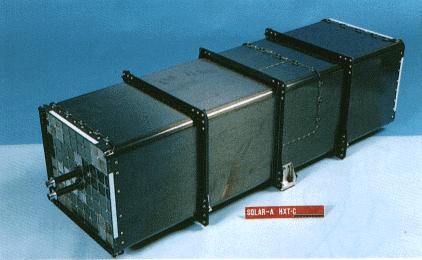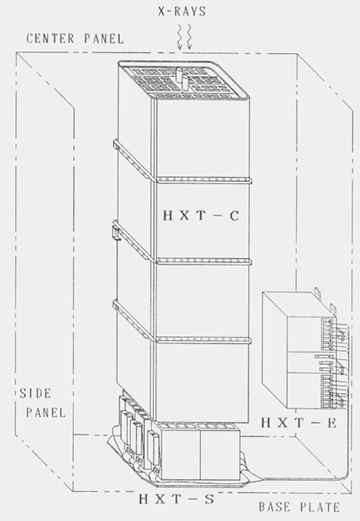HXT is a Fourier synthesis type imager consisting of 64 bi-grid modulation
subcollimators (SC's). Each SC has a different pitch and/or a position angle
of collimator grids, together with a NaI (Tl) scintillation crystal and
a detector photomultiplier located behind the SC.
The number of hard X-ray photons passing through a single SC is periodically
modulated with respect to the incident angle, which gives a modulation pattern
of the corresponding SC, and count rate data obtained by each detector which can
be regarded as a spatial Fourier component (+ DC level) of a hard X-ray image.
When a flare-mode is triggered, a set of 64 hard X-ray count rate data is
accumulated every 0.5 s (= the highest temporal resolution) in four energy
bands between 14 and 93 keV (L, M1, M2, and H bands, respectively) and
is transferred from HXT to the Data Processor (DP).
The data are then telemetered down to the ground and hard X-ray images can be
synthesized using image restoration procedures such as the Maximum Entropy
Method (MEM). The field-of-view (FOV) of HXT is about 35 by 35 arcminutes,
i.e. covering the whole Sun.
This means that HXT can detect hard X-rays of flares regardless of their
position on the Sun without re-pointing the spacecraft.
The basic image synthesis FOV of HXT is 2.1 by 2.1 arcminutes with the angular
resolution as high as approximately 5 arcseconds.
A detailed description on the overview of the instrument is given by
Kosugi et al. (1991).
See Kosugi et al. (1992) for the in-orbit performance of HXT as well as
some initial results.
References
- Kosugi, T., Makishima, K., Murakami, T., Sakao, T., Dotani, T., Inda, M.,
Kai, K., Masuda, S., Nakajima, H., Ogawara, Y., Sawa, M., and Shibasaki, K.
1991 : Solar Phys., 136, 17.
- Kosugi, T., Sakao, T., Masuda, S., Makishima, K., Inda, M., Murakami,
T., Ogawara, Y., Yaji, K., and Matsushita, K.
1992 : Publ. Astron. Soc. Japan, 44, L45.
HXT Figures (click to enlarge).
HXT spectral response.




